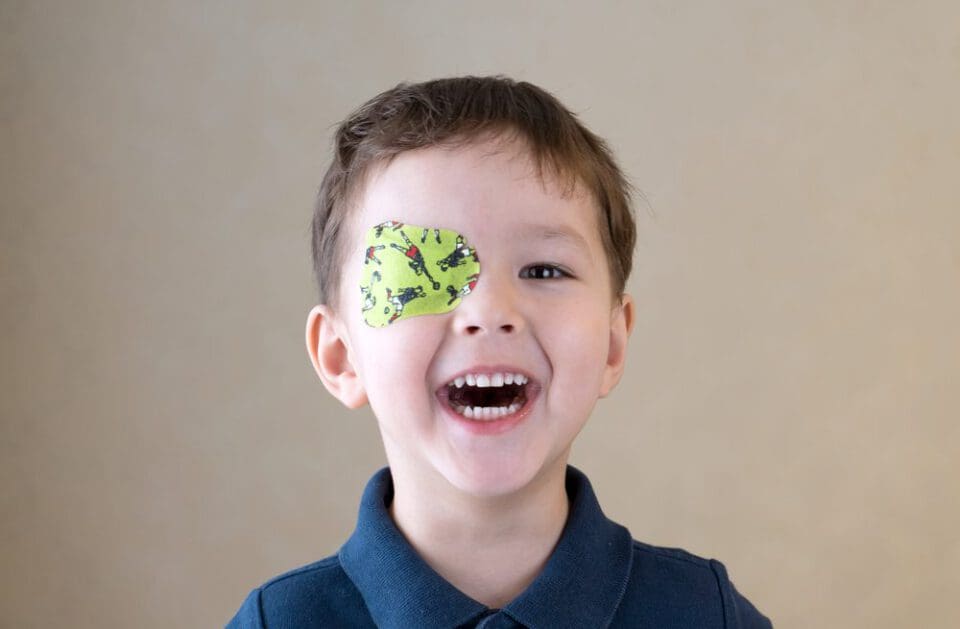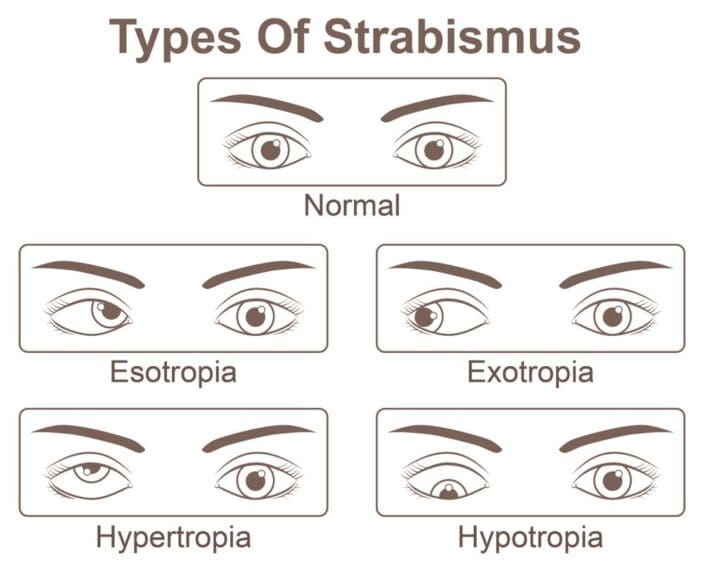How Does Wearing an Eye Patch Affect Your Good Eye?
Home / Vision Education Center /
Last Updated:
Eye patches can be used to treat different types of eye conditions. They have been used successfully for centuries to manage poor vision.
Table of Contents
Childhood conditions like amblyopia and strabismus have long benefitted from the child wearing an eye patch for a few hours a day. For adults, wearing an eye patch for a few days to protect an eye after certain surgical procedures can be useful.
Self-treating an eye condition like eye strain with an eye patch or cutting off one eye to prevent double vision will not help your eyes in the long term. While you will not hurt vision in your dominant eye, you could be putting off important medical treatment for an underlying vision problem.
Common Reasons to Wear an Eye Patch
People wear eye patches for different reasons, some cosmetic, others therapeutic. Some common objectives for covering your eye include:
- To treat poor vision in children, such as due to lazy eye or crossed eyes
- To protect your eye after cataract surgery
- To prevent swelling after eye removal surgery
- To protect your eye after incurring trauma to your eye or areas in the eye cavity area
- To improve physical appearance after eye removal or due to disfiguring eye scars
You deserve clear vision. We can help.
With 135+ locations and over 2.5 million procedures performed, our board-certified eye surgeons deliver results you can trust.
Your journey to better vision starts here.
How Do Eye Patches Affect Vision?
For children, eye patches may be prescribed for certain eye conditions, generally to improve vision in a non-dominant eye. In adults, eye patches are often used to protect one eye, particularly after surgery.
There are instances when wearing an eye patch will not solve the problem. Many eye specialists are researching better approaches to treatment so both eyes can become stronger together. However, many Americans have benefitted from wearing eye patches at some point in their vision treatment.

Wearing an eye patch, as prescribed by an eye doctor, will protect vision in your good eye and can help your non-dominant eye. But it is important to work with medical professionals. You should not self-treat symptoms that may need other help.
Using Eye Patches to Improve or Protect Vision
Here are some cases in which wearing an eye patch helps to treat vision problems:
Amblyopia
In the average person, both eyes work together to produce a three-dimensional image in the brain. Light enters both pupils and focuses on both retinas, and that signal moves through the optic nerve to become an image in the brain. In people who have amblyopia, one eye is favored by the brain over the other eye, which leads to atrophy of the optic nerve in the less used eye. Both eyes will appear normal, especially in children, although this atrophy may lead to lazy eye, or strabismus, as a secondary effect.
Amblyopia effects between 2 and 3 out of every 100 children in the United States.
The first line of treatment when the condition is diagnosed, especially in younger children, is for a pediatric ophthalmologist to prescribe an eye patch over your child’s dominant eye. This will train the brain to use the other eye and strengthen it. This treatment does not weaken the dominant eye, but instead helps the brain pick up signals so both eyes can work better together.
If amblyopia is not treated earlier in childhood, it can persist into adulthood, although medical researchers are working on treatments for older children and adults.
It is rare in amblyopia treatment for eye patches to lead to vision loss in the dominant eye, but it is possible. Follow-up eye exams with your pediatric ophthalmologist can help to prevent this issue.
Strabismus

This condition is sometimes called lazy eye. It is a visual problem caused by one eye not properly aligning with the other and pointing in a different direction than the dominant eye. Sometimes, the eye points in toward the nose (esotropia); in other instances, it points outward, away from centrally aligned vision (exotropia).
About 4 percent of children in the U.S. have strabismus. It can lead to double vision, be a symptom of amblyopia, or cause other vision problems if it is not treated.
Diagnosing strabismus requires an optometrist or ophthalmologist even if the condition is noticeable. When treated early in life, your child may wear glasses to properly align the eyes, or your pediatric eye doctor may recommend an eye patch over the dominant eye to strengthen the muscles in the non-dominant eye. This treatment approach is similar to amblyopia treatment.
Children with esotropia may require surgery, however, to properly align their eyes. They may receive an eye patch after this treatment to continue to strengthen the eye.
After surgery
Eye patches are not given to adults to treat amblyopia or strabismus, but after almost any type of eye surgery, you are likely to receive an eye patch to protect your eye for a day or two. For example, after LASIK, you may wear a patch at night to prevent accidental scratching or bumping of your healing cornea. After surgery to treat macular pucker, you will wear an eye patch for a few days to protect the eye.
How to Make an Eye Patch More Comfortable
Wearing a patch isn’t always simple, and it won’t feel right at first, especially for children.
The skin around your eye can be sensitive to the adhesive on a patch, and the eye covering could irritate the area. You’ll also want to minimize the sting when you’re removing the patch.
Once you make it more comfortable to wear, it’s easier to get your child to patch the prescribed number of hours each day. This treatment generally works faster when you follow the patching dosage strictly.
But there are ways to make the process easier and to make long-term use comfortable. Among the most practical ways to alleviate common eye patch discomfort:
- Use a warm compress when pulling the patch off to minimize the sting on the skin.
- Lubricate the patched area after patch removal. This will help minimize chafing. For example, you can apply skin lotion on the area every day before you go to bed.
- Consider that you may need to try more than one brand of patch if the brand you are using won’t stop irritating you. It’s possible you have an allergy to something in the patch. Your doctor can recommend some hypoallergenic options if this is a persistent problem for your child.
- If you have to use a sticky eye patch, carefully rub milk of magnesia liquid on the skin area to be patched and stick the patch after the liquid has dried. The milk of magnesium layer prevents direct contact between the adhesive and the skin, alleviating or preventing irritation.
- You can use non-sticky eye patches to avoid skin irritation and chafing, especially on older children. However, these are ineffective when the child is able to peek around the eye patch.
- Consider that you’re using the wrong eye patch size if the current one is causing discomfort.
You deserve clear vision. We can help.
With 135+ locations and over 2.5 million procedures performed, our board-certified eye surgeons deliver results you can trust.
Your journey to better vision starts here.
Eye Patches Are Not Always Appropriate Treatment
While there are instances in which an eye patch is appropriate, wearing one without the suggestion from an optometrist or ophthalmologist may not help your eyes long term.
Although it is rare for an eye patch to hurt your vision, it is possible that wearing a patch may temporarily treat symptoms that would benefit more from a medical diagnosis and a long-term approach to treatment.
Glaucoma
Eye fatigue can be associated with glaucoma, which is damage to the retina most often caused by high fluid pressure in the eye. Some people may wear an eye patch for close-up work or computer work to reduce eye strain in the eye that has more vision loss. While this may seem like a good temporary solution, it is important to talk to your ophthalmologist about other methods for managing eye strain. Wearing an eye patch will not cause worsening vision in the dominant eye, but it could add to strain in that eye, which may become uncomfortable.
Double Vision
There are several eye conditions in adults that may cause double vision, including cataracts or central serous chorioretinopathy. These eye diseases require other treatment, and eye patches will not improve problems caused by one eye being more out of focus than the other.
If you try to wear an eye patch without going to an optometrist or ophthalmologist first, the eye condition could progress due to lack of proper treatment. If you experience double vision, always get a diagnosis with an eye doctor. Do not try to treat it yourself.
See a Doctor

Eye patches are important parts of treating certain eye conditions, and they can improve or protect vision in your eyes — whether you are wearing the patch to manage vision in a non-dominant eye or because you are protecting your good eye.
But wearing an eye patch to self-treat an eye condition is not likely to work. Always report symptoms, especially if they are new or get worse quickly, to an optometrist or ophthalmologist.
You deserve clear vision. We can help.
With 135+ locations and over 2.5 million procedures performed, our board-certified eye surgeons deliver results you can trust.
Your journey to better vision starts here.
References
- Facts About Amblyopia. (September 2013). National Eye Institute (NEI).
- Will Wearing an Eye Patch for 8 to 12 Hours a Day on a Good Eye Cause Any Long-Term Damage to the Eye? (March 15, 2018). American Academy of Ophthalmology (AAO).
- What Is Strabismus? (April 14, 2014). American Academy of Ophthalmology (AAO).
- Strabismus Treatment. (September 10, 2017). American Academy of Ophthalmology (AAO).
- Macular Pucker Defined. (April 2012). National Eye Institute (NEI).
- Am I Doing Any Damage to the Eye With Glaucoma if I Wear an Eyepatch When My Eye Is Tired? (December 11, 2013). American Academy of Ophthalmology (AAO).
- Can I Use an Eye Patch to Treat Double Vision if I Have Central Serous Chorioretinopathy? (November 22, 2017). American Academy of Ophthalmology (AAO).
This content is for informational purposes only. It may have been reviewed by a licensed physician, but is not intended to serve as a substitute for professional medical advice. Always consult your healthcare provider with any health concerns. For more, read our Privacy Policy and Editorial Policy.
